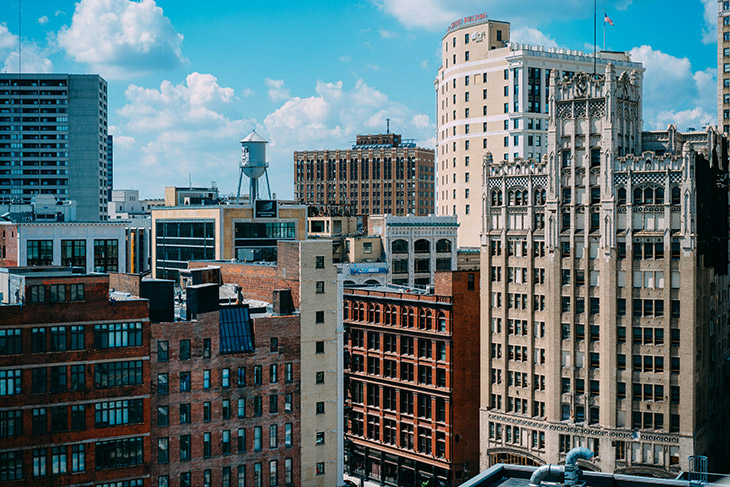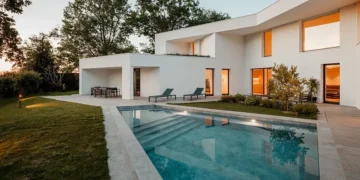
Architecture in the United States reflects the country’s expansive diversity, revealing layers of cultural history, migration, and regional identity. While jobs and family obligations often dictate where people settle, the surrounding architecture can deeply shape the experience of living in a place. Each region presents a distinct architectural language shaped by history, climate, and cultural influences. Let’s explore the defining styles of American architecture across key regions and uncover what makes each unique.
The Rust Belt
The Rust Belt is often associated with economic decline, but this region’s architectural heritage reveals a rich and opulent past. During the 19th and early 20th centuries, cities such as Detroit, Cleveland, and Buffalo thrived as industrial centers. Wealthy industrialists built grand homes in Victorian, Beaux-Arts, and Craftsman styles, leaving behind intricate facades, stained glass windows, and elaborate woodwork. Public buildings in the region also feature Art Deco elements, especially in theaters, office buildings, and train stations.
Though some neighborhoods have fallen into disrepair, restoration efforts in places like Buffalo and Detroit are reviving these architectural gems. These homes and public spaces stand as reminders of the wealth and innovation that once defined the Rust Belt. The interplay between grandeur and decline gives the region a distinctive charm, attracting those with an appreciation for history and urban renewal.

South and Southwest US
Traveling across the South and Southwest reveals a wide range of architectural influences, each shaped by history, climate, and culture. If you have the opportunity to choose your next home, consider taking a drive across the region to witness the diverse changes along the way. When you’re ready to relocate, enlist a reliable moving company like Elate Moving to ensure a smooth transition. Now, let’s explore the unique offerings of the South.
Florida
Florida’s architecture reflects its tropical climate and evolving urban landscape. Florida vernacular homes – raised on stilts with metal roofs and wide porches – are common in coastal areas like Key West, designed to combat heat and humidity. These homes offer a simple, functional design suited to the state’s subtropical environment.
In contrast, Miami’s South Beach is renowned for its vibrant Art Deco district, with pastel-colored buildings, geometric patterns, and neon lights defining its visual identity. Further north, St. Augustine, the oldest continuously inhabited European settlement in the U.S., showcases Spanish colonial and Mediterranean Revival architecture, with red-tiled roofs and arched doorways adding to the city’s charm.
The Deep South
The Deep South boasts a rich architectural heritage, where antebellum homes serve as enduring symbols of the region’s history. Built in Georgian, Greek Revival, and Federal styles, these grand estates feature symmetrical facades, stately columns, and expansive lawns. These homes functioned both as social centers and retreats from the summer heat.
During the Victorian period, wrap-around porches became more common, reinforcing the tradition of outdoor living. Cities like Charleston and Savannah preserve many of these historic homes, blending old-world charm with modern urban life. The architecture of the Deep South reflects a blend of hospitality, tradition, and cultural resilience.

The Southwest
The Southwest offers a distinct architectural identity shaped by Native American, Spanish, and Mexican influences. Adobe structures, made from sun-dried earth bricks, are emblematic of the region. In Santa Fe, New Mexico, local ordinances enforce a Pueblo Revival style, requiring new buildings to incorporate adobe-like features to maintain architectural continuity. Even chain establishments, including McDonald’s, adapt their designs to fit the local aesthetic.
Santa Fe is also home to San Miguel Chapel, one of the oldest churches in the United States, built in 1610. The region’s architecture reflects sustainable practices suited to the desert environment and draws visitors interested in its cultural heritage. Adobe-style structures remain central to the area’s identity, combining historical tradition with modern functionality.
California
California offers a diverse architectural landscape shaped by geography and cultural history. In Southern California, Spanish Colonial Revival homes with white stucco walls, red-tiled roofs, and open courtyards reflect the area’s colonial past. These homes coexist with modernist bungalows and mid-century houses, reflecting the region’s emphasis on relaxed, indoor-outdoor living.
Further north, San Francisco is known for its iconic Victorian “Painted Ladies,” homes with ornate woodwork and colorful facades lining the city’s hilly streets. Palm Springs stands out as a hub for mid-century modern architecture, with sleek lines, flat roofs, and expansive glass walls that blend with the desert environment. In Silicon Valley and the Bay Area, contemporary sustainable designs focus on energy efficiency and environmental harmony. California’s architecture offers a mix of historical influences and forward-thinking innovation.

See for yourself
The architecture of the United States tells stories of innovation, resilience, and cultural exchange. Each region’s buildings embody the challenges and triumphs of the people who shaped them, from the ornate mansions of the Rust Belt to the adobe structures of the Southwest. The Deep South’s grand estates stand as symbols of a complex history, while California’s eclectic styles reflect its forward-looking spirit and rich cultural heritage.
Experiencing these architectural styles firsthand provides insight into how design interacts with history and environment. Whether you wander through Charleston’s historic neighborhoods, admire Palm Springs’ mid-century marvels, or stroll along Miami’s Art Deco avenues, architecture offers a way to engage with the past and present simultaneously.




















Statue of Liberty lol, ahaha so many iconic projects that you missed here guys